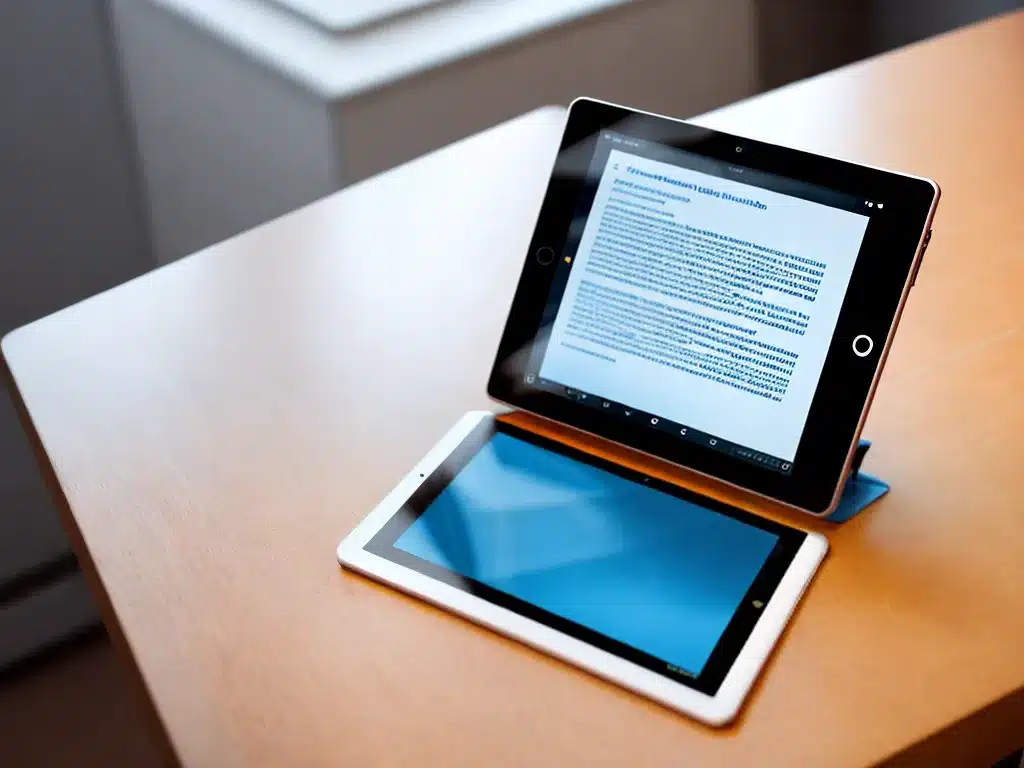
Introduction
Tablets have become increasingly popular over the past decade as an alternative to traditional laptop computers. With powerful processors, touchscreens, and intuitive interfaces, tablets seem poised to replace laptops for many users. However, the question remains – are tablets a truly viable laptop alternative? In this article, I will examine the key factors to consider when evaluating tablets as laptop replacements.
Portability
One of the biggest advantages of tablets is their superior portability compared to most laptops.
- Tablets like the iPad Pro 11″ and Microsoft Surface Pro weigh around 1 pound, whereas most laptops weigh at least 2-3 pounds.
- Tablets can easily fit into bags and purses, making them highly convenient to take anywhere.
- The compact form factor of tablets also makes them great for use while standing or when space is limited, like on an airplane.
For users that need maximum portability, tablets provide a clear edge over bulkier and heavier laptops. The lightweight, slim design makes tablets easy to take on-the-go.
Hardware Capabilities
Modern tablets are powered by robust processors and hardware that allow them to handle intensive tasks:
- Tablets use processors like the A12Z Bionic (iPad Pro) and Intel Core i7 (Surface Pro) that deliver laptop-level performance.
- High-end tablets can be configured with up to 16GB RAM and 1TB storage, on par with many laptops.
- Graphics capabilities have greatly improved in tablets, enabling gaming, video editing, and other graphically intensive use cases.
For most common productivity tasks like web browsing, document editing, email, and media consumption, a high-end tablet’s hardware is very capable. Tablets may fall short for specialized tasks like high-end video editing and gaming.
Operating System and Software
The operating system and app ecosystem play a major role in determining a tablet’s capabilities:
- iPads run the streamlined iPadOS that offers intuitive touch-based interaction and access to Apple’s robust App Store with high-quality tablet apps.
- Android tablets provide flexible customization and Google Play Store access but lag iPads in tablet-optimized apps.
- Windows tablets allow full Windows software compatibility but can have limitations with touchscreen integration.
Tablets running operating systems designed for touch excel at quick interactions like note-taking but may fall short for prolonged workflows demanding mouse/trackpad input.
Battery Life
One universal shortcoming of tablets is battery life:
- Most premium tablets manage 6-10 hours of battery life with mixed usage.
- Laptops can easily achieve 10-15 hours thanks to bigger batteries.
- Continual intensive work will drain a tablet’s battery faster than a laptop.
If you need to use your device for extended periods without charging, laptops have a clear battery life advantage. Tablets require charging more frequently.
Text Input
Entering large amounts of text is a challenge on tablets:
- On-screen keyboards lack the tactile feedback of physical keys, making prolonged typing difficult.
- External keyboard cases improve the experience but reduce portability.
- Handwriting and dictation input can help but may impact workflow speed.
For productivity tasks requiring significant typing, a laptop’s physical keyboard allows faster and more comfortable text input. Tablets work best for shorter text entries.
Multitasking
Tablets are designed for focused use of one app at a time:
- Interactions revolve around full-screen apps rather than multi-window workflows.
- Certain tablets like iPads allow split-screen multitasking but with limited capabilities.
- Laptops enable more flexible windowing, tiling, and organization of multiple apps simultaneously.
If your work demands the ability to view and interact with many apps at once, a laptop may offer superior multitasking capabilities over a tablet.
Price
With premium build quality and components, high-end tablets carry laptop-grade pricing:
- Top tablets like the 12.9″ iPad Pro (starting at $999) and Microsoft Surface Pro 8 (starting at $999) cost as much as high-end laptops.
- Laptops provide more versatility at lower price points like $500.
- However, affordable tablet options like the 10.2″ iPad (starting at $329) do exist.
Tablets can appear overpriced if you don’t need maximum performance and portability. But for replacing a premium laptop, an equally high-spec tablet costs similarly.
Conclusion
Tablets make an outstanding laptop alternative if ultra-portability, touchscreen functionality, and streamlined mobile OS capabilities align with your needs. For intensive productivity requiring heavy text entry, complex multitasking, and extended battery life, traditional laptops retain advantages. Consider your specific usage needs and hardware priorities before deciding between these two capable mobile computing options. With the right match between device capabilities and your workflow, both tablets and laptops can enable great productivity and user experience.












